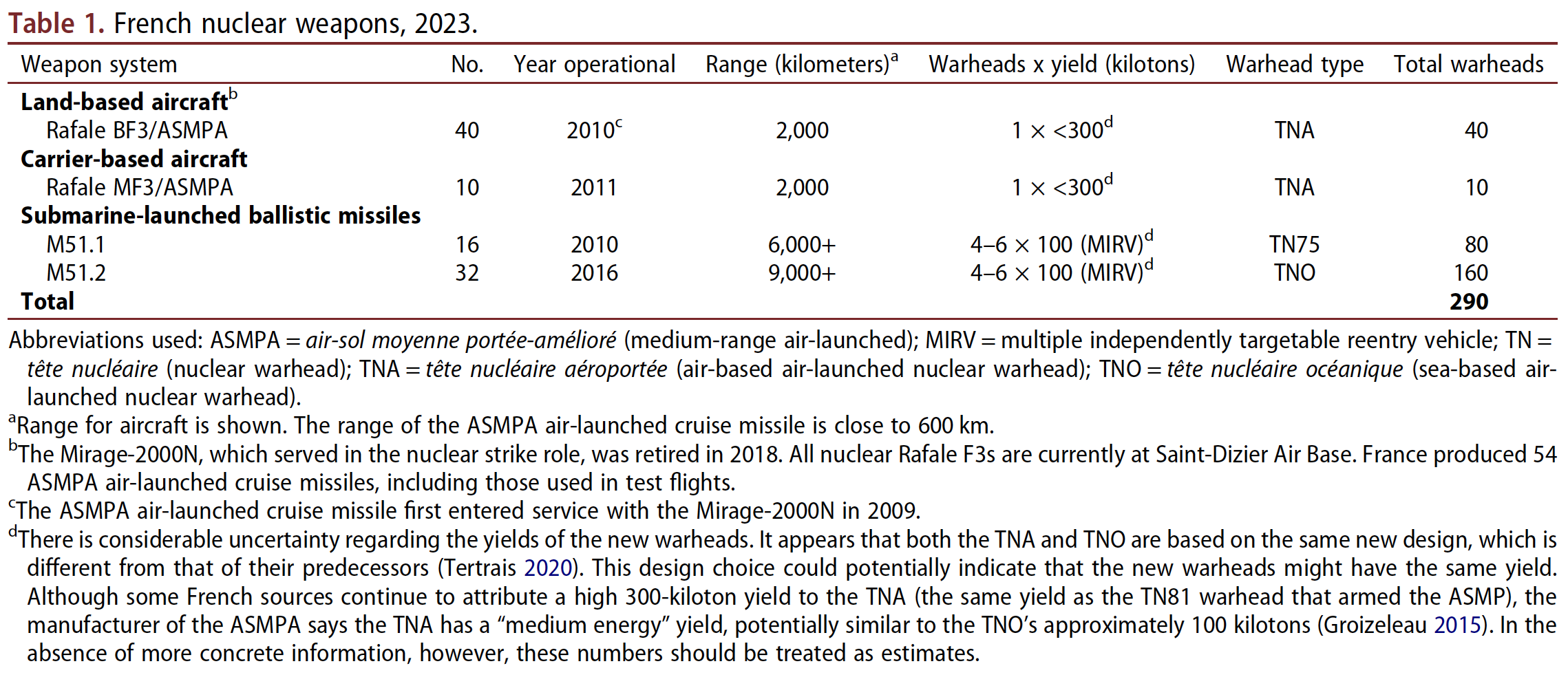| Nuclear Notebook: French nuclear weapons, 2023
核笔记本:法国核武器,2023年 Date:2023-09-24 Source:FAS By:Hans M. Kristensen, M Viewed: |
By Hans M. Kristensen, Matt Korda, Eliana Johns, July 17, 2023
作者:汉斯·M·克里斯滕森,马特·科尔达,伊莉亚娜·约翰斯,2023年7月17日
rance’s nuclear arsenal has remained stable over the past decade and contains approximately 290 warheads. This number is slightly lower compared to past Nuclear Notebook estimates because a small number of warheads previously thought to be spares or in maintenance are no longer counted as separate from the stockpile. Nearly all of France’s warheads are deployed or operationally available for deployment on short notice.
法国的核武库在过去十年中一直保持稳定,拥有约290枚弹头。与过去的《核笔记本》估计相比,这一数字略低,因为以前被认为是备件或正在维修的少量弹头不再被视为与库存分开的弹头。法国几乎所有的弹头都已部署或可在短时间内部署。
Other than the United States, France is the most transparent of the nuclear-armed states, having disclosed details about its nuclear forces and operations for many years. The current force level is the result of adjustments made to France’s nuclear posture following former President Nicolas Sarkozy’s announcement on March 21, 2008, that the arsenal would be reduced to fewer than 300 warheads (Sarkozy 2008). Former President François Hollande reaffirmed this posture on February 19, 2015, when he declared that France had a stockpile of 300 warheads for “three sets of 16 submarine-based missiles and 54 ASMPA [medium-range air-launched] delivery systems” (Hollande 2015). President Emmanuel Macron reaffirmed the Sarkozy formulation of “under 300 nuclear weapons” in a speech on February 7, 2020 (Élysée 2020) (See Table 1).
除了美国,法国是拥有核武器的国家中最透明的,多年来一直披露其核力量和核行动的细节。目前的兵力水平是前总统尼古拉·萨科齐于2008年3月21日宣布将武器库减少到300枚以下(萨科齐,2008年)之后对法国核态势进行调整的结果。2015年2月19日,前总统弗朗索瓦·奥朗德重申了这一立场,他宣布法国拥有300枚弹头,用于“三套16枚潜基导弹和54枚ASMPA(中程空射)运载系统”(奥朗德,2015年)。埃马纽埃尔·马克龙总统在2020年2月7日的一次演讲中重申了萨科齐提出的“300枚以下核武器”(爱丽舍宫 2020)(见表1)。
表1。(点击放大。)
As Sarkozy said in 2008, the 300-warhead stockpile is “half the maximum number of warheads [France] had during the Cold War” (Sarkozy 2008). By our estimate, the French warhead inventory peaked in 1991–1992 at around 540 warheads, and the size of today’s stockpile is about the same as it was in 1984, although the composition is significantly different.
正如萨科齐在2008年所说,300枚核弹头的库存是“冷战期间(法国)核弹头最大数量的一半”(萨科齐,2008年)。据我们估计,法国的核弹头库存在1991-1992年达到峰值,约为540枚,今天的库存规模与1984年大致相同,尽管组成明显不同。
France’s nuclear doctrine
法国的核学说
Successive heads of state, including Presidents Sarkozy, Hollande, and now Macron, have periodically described the role of French nuclear weapons. The Defense Ministry’s 2017 Defense and National Security Strategic Review reiterated that the nuclear doctrine is “strictly defensive,” and that using nuclear weapons “would only be conceivable in extreme circumstances of legitimate self-defense,” involving France’s vital interests. What exactly these “vital interests” are, however, remain unclear. In February 2020, President Emmanuel Macron announced that France’s “vital interests now have a European dimension,” and sought to engage the European Union on the “role played by France’s nuclear deterrence in [its] collective security” (Élysée 2020). Macron clarified in October 2022 that these vital interests “would not be at stake if there was a nuclear ballistic attack in Ukraine or in the region,” apparently attempting to avoid being seen as expanding French nuclear doctrine (France TV 2022). Explicitly ruling out a nuclear role in case of Russian nuclear escalation in Ukraine appeared to contradict France’s statement at the August 2022 Review Conference for the Treaty on the Non-Proliferation of Nuclear Weapons, which explained that “for deterrence to work, the circumstances under which nuclear weapons would [or would not] be used are not, and should not be, precisely defined, so as not to enable a potential aggressor to calculate the risk inherent in a potential attack” (2020 Review Conference of the Parties to the Treaty on the Non-Proliferation of Nuclear Weapons 2022).
包括萨科齐总统、奥朗德总统和现在的马克龙在内的历届国家元首都定期描述法国核武器的作用。法国防部2017年《国防和国家安全战略评论》重申,核理论是“严格防御性的”,使用核武器“只有在合法自卫的极端情况下才是可能的”,涉及法国的切身利益。然而,这些“重大利益”究竟是什么,目前尚不清楚。2020年2月,法国总统埃马纽埃尔·马克龙宣布,法国的“重大利益现在具有欧洲层面”,并寻求与欧盟就“法国的核威慑在[其]集体安全中发挥的作用”进行接触(爱丽舍宫 2020)。马克龙在2022年10月澄清说,“如果乌克兰或该地区发生核弹道袭击,这些重大利益将不会受到威胁”,显然是为了避免被视为扩大法国的核理论(法国电视台 2022)。明确排除在俄罗斯在乌克兰核升级的情况下发挥核作用似乎与法国在2022年8月举行的《不扩散核武器条约》审议大会上的声明相矛盾,其中解释说,“为了使威慑发挥作用,没有也不应该准确定义将[或不会]使用核武器的情况,以免潜在侵略者能够计算潜在袭击所固有的风险”(不扩散核武器条约缔约国2020年审议大会 2022)。
France does not have a no-first-use policy and reserves the right to conduct a “final warning” limitednuclear strike to signal to an adversary that they have crossed a line—or to signal the French resolve to conduct further nuclear strikes if necessary—in an attempt to “reestablish deterrence” (Élysée 2020; Tertrais 2020). Although France is a member of NATO, its nuclear forces are not part of the Alliance’s integrated military command structure. The Defense Ministry’s 2013 White Paper says the French nuclear deterrent “ensures, permanently, our independence of decision-making and our freedom of action within the framework of our international responsibilities, including in the event of any threat of blackmail that might be directed against us in the event of a crisis” (French Ministry of Defense 2013). If an aggressor is not deterred, President Macron explained in 2020, France’s “nuclear forces are capable of inflicting absolutely unacceptable damages upon that State’s centers of power: its political, economic and military nerve centers” (Élysée 2020). For a more in-depth examination on the evolution of France’s nuclear doctrine, see Bruno Tertrais’ authoritative report, “French Nuclear Deterrence Policy, Forces and Doctrine” (Tertrais 2020).
法国没有不首先使用核武器的政策,并保留进行“最后警告”有限核打击的权利,以向对手发出他们越界的信号,或表明法国决心在必要时进行进一步的核打击,以试图“重建威慑”(爱丽舍宫 2020;泰特拉斯 2020)。尽管法国是北约成员国,但其核力量不属于北约综合军事指挥结构的一部分。法国国防部2013年白皮书称,法国核威慑力量“永久确保我们在国际责任框架内的决策独立性和行动自由,包括在发生危机时可能针对我们的任何勒索威胁时”(法国国防部 2013)。马克龙总统在2020年解释说,如果侵略者不被吓倒,法国的“核力量有能力对该国的权力中心:其政治、经济和军事神经中心造成绝对不可接受的损害”(爱丽舍宫 2020)。关于法国核理论演变的更深入研究,请参阅布鲁诺·特尔特拉斯的权威报告《法国核威慑政策、力量和理论》(泰特拉斯 2020)。
During a hearing in the French Parliament on January 11, 2023, General Thierry Burkhard, the French Chief of Defense, further explained France’s nuclear doctrine: “[Our deterrent] is not articulated around the notion of threshold, because it would allow our adversaries to maneuver around in conscience and circumvent our deterrence ‘from the bottom up.’ Our deterrence capability guarantees second-strike possibilities through the redundancy of resources and the invulnerability of the sea-based leg. The possibility of using the nuclear weapon first is assumed: our doctrine is neither that of no first use nor that of the sole purpose, according to which nuclear weapons are only addressed to the nuclear threat … Nuclear deterrence does not seek to win a war or prevent losing one” (Burkhard 2023; our translation).
2023年1月11日,在法国议会举行的听证会上,法国国防部长蒂埃里·伯克哈德将军,进一步解释了法国的核理论:“(我们的威慑力量)没有围绕门槛的概念进行阐述,因为这将允许我们的对手凭良心行事,并“自下而上”规避我们的威慑,我们的威慑能力通过资源的冗余和海基支柱的无懈可击来保证第二次打击的可能性。假设首先使用核武器的可能性:我们的学说既不是不首先使用,也不是唯一目的,根据这一学说,核武器只针对核威胁……核威慑并不寻求赢得战争或防止输掉战争”(伯克哈德 2023;我们的翻译)。
Concerning the implications of the Russia-Ukraine war for the role of nuclear weapons, Burkhard said: “The war in Ukraine confirms the strategic value of nuclear deterrence and its moderating effect in any conflict involving one or more nuclear powers. Everyone has also noted a great restraint on the part of the Russian forces vis-à-vis NATO … The other lesson to be learned from the Ukraine war is of course the return of the balance of terror by the threat of force, a customary action during the Cold War” (Burkhard 2023; our translation).
在谈到俄乌战争对核武器作用的影响时,伯克哈德说:“乌克兰战争证实了核威慑的战略价值,以及它在任何涉及一个或多个核大国的冲突中的缓和作用。”每个人都注意到俄罗斯军队对北约的极大克制。从乌克兰战争中得到的另一个教训当然是通过武力威胁恢复恐怖平衡,这是冷战期间的一种习惯行动”(伯克哈德 2023;我们的翻译)。
France typically conducts four air-based nuclear exercises each year, known as “Poker.” These exercises are intended to simulate a strategic air raid and are conducted in the skies above France (see Figure 1). The “Poker” exercise involves a majority of France’s nuclear-capable Rafale aircraft, which carry simulated air-sol moyenne portée-amélioré (ASMPA) air-launched cruise missiles (Air & Cosmos International 2022; Service de l’Information Aéronautique 2022). The most recent “Poker” exercise was conducted in March 2023, and included nuclear-capable Rafale aircraft from both the Forces Aériennes Stratégiques (FAS) and the Force Aéronavale Nucléaire (FANu) (Marine Nationale 2023).
法国通常每年进行四次空中核演习,称为“扑克”。这些演习旨在模拟战略空袭,在法国上空进行(见图1)。“扑克”演习涉及法国大部分具有核能力的阵风飞机,这些飞机携带模拟的空射巡航导弹(国际航空航天局 2022;信息服务局 2022)。最近的一次“扑克”演习于2023年3月进行,包括来自战略力量(FAS)和国家海军陆战队(FANu)的具有核能力的阵风飞机。
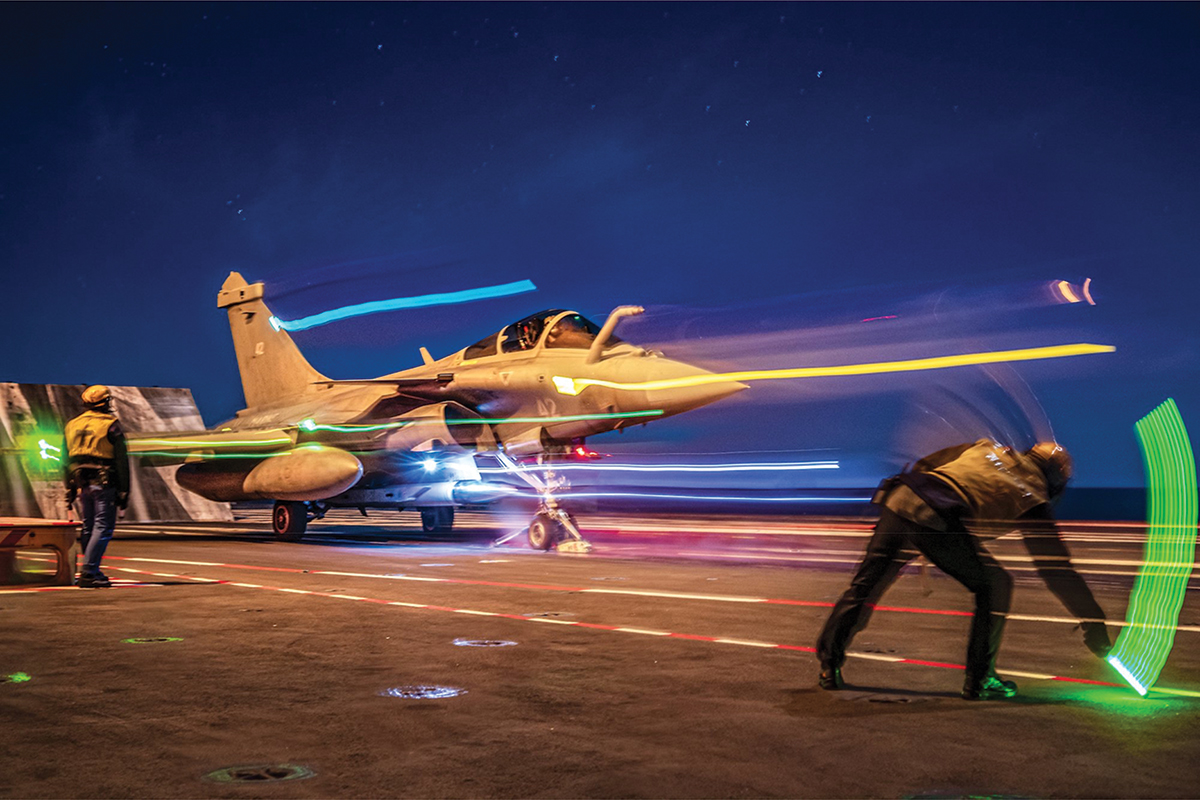
Figure 1. A Rafale loaded with an unarmed ASMPA nuclear cruise missile takes off from the Charles de Gaulle aircraft carrier in the Mediterranean Sea during the Poker nuclear strike exercise in March 2023. (Image: French Navy).

Figure 1. A Rafale loaded with an unarmed ASMPA nuclear cruise missile takes off from the Charles de Gaulle aircraft carrier in the Mediterranean Sea during the Poker nuclear strike exercise in March 2023. (Image: French Navy).
图1。2023年3月,在“扑克”核打击演习期间,一架装载着非武装ASMPA核巡航导弹的阵风从地中海上的戴高乐航空母舰上起飞。(图片:法国海军)。
Under President Macron, France has engaged in a long-term modernization and strengthening of its nuclear forces. The 2018 Law on Military Planning (Loi de Programmation Militaire, or LPM) for 2019 through 2025 allocated €37 billion ($43.7 billion) for maintenance and modernization of France’s nuclear forces and infrastructure (Assemblée Nationale 2023). This was a significant nominal increase from the €19.7 billion ($21.8 billion) allocated by the LPM for 2015 through 2019 (Journal Officiel de la République Française 2013). The 2022 budget of the Ministry of the Armed Forces (France’s defense ministry) allocated €5.3 billion ($6.3 billion) to nuclear weapon-related activity, which was €0.3 billion more than in the 2021 budget (MAF 2022, 43; Rose 2020). This number increased again when France released its 2023 budget plans, allocating €5.6 billion ($6.14 billion) toward modernizing its nuclear forces (MAF 2023, 41).
在马克龙总统的领导下,法国长期致力于核力量的现代化和加强。2018年《军事规划法》(Loi de Programmation Militaire,简称LPM)为2019年至2025年拨款370亿欧元(437亿美元)用于法国核力量和基础设施的维护和现代化(2023年国民议会)。这比2015年至2019年LPM分配的197亿欧元(218亿美元)有了显著的名义增长(《法国共和国官方杂志》,2013年)。武装部队部(法国国防部)2022年预算为核武器相关活动拨款53亿欧元(63亿美元),比2021年预算多3亿欧元(MAF 2022,43;罗斯 2020)。当法国发布2023年预算计划时,这一数字再次增加,拨款56亿欧元(61.4亿美元)用于核力量现代化(MAF 2023,41)。
Submarine-launched ballistic missiles
潜射弹道导弹
The French force of submarine-launched ballistic missiles (SLBMs) constitutes the backbone of the French nuclear deterrent. Under the command of the Strategic Ocean Force (Force Océanique Stratégique, or FOST), the French Navy (Marine Nationale) operates four Triomphant-class nuclear-powered ballistic missile submarines (SSBNs) equipped with nuclear-armed long-range ballistic missiles—Le Triomphant (hull number S616), Le Téméraire (S617), Le Vigilant (S618), and Le Terrible (S619).
法国的潜射弹道导弹部队构成了法国核威慑力量的支柱。在战略海洋部队(战略海洋部队,简称FOST)的指挥下,法国海军(国民海军陆战队)操作着四艘配备有核武装远程弹道导弹的“凯旋”级核动力弹道导弹潜艇(SSBN)——“凯旋号”(船体编号S616)、“无畏号”(S617)、“警戒号”(S618)和“可怖号”(S619)。
Like the other Western nuclear powers, the French Navy maintains a continuous at-sea deterrent posture with at least one boat on patrol, one preparing for patrol, one returning to port, and one in maintenance. Each submarine patrol lasts an average of approximately 70 days, and FOST completed its 500th deterrent patrol in July 2018 when Le Téméraire returned to Île Longue, marking 46 years of continuous SSBN patrols since the first one in 1972 (French Ministry of Defense 2018b). In March 2022, the French Navy temporarily deployed more than one SSBN for the first time since the 1980s, likely in response to Russia’s invasion of Ukraine (Newdick 2022).
与其他西方核大国一样,法国海军保持着持续海上威慑态势,至少有一艘在巡逻,一艘准备巡逻,一艘返回港口,一艘在维修。每次潜艇巡逻平均持续约70天,2018年7月,当“无畏号”返回朗格岛时,FOST完成了第500次威慑巡逻,标志着自1972年第一次巡逻以来,SSBN连续巡逻46年(法国国防部2018b)。2022年3月,法国海军自20世纪80年代以来首次临时部署了一艘以上的弹道导弹核潜艇,可能是为了应对俄罗斯打击乌克兰(纽迪克 2022)。
The SSBN force is based at the Île Longue naval base near Brest in Brittany, which includes two drydocks, nuclear warhead storage, and a unique facility with what appears to be 24 vertical silos for storing missiles that are not loaded on submarines. The missiles are assembled about four kilometers south of the base at the Guenvénez pyrotechnic site. Long-term submarine repairs and refueling take place at the Brest naval base across the bay, which has three large drydocks (Naval Technology n.d.). The SSBNs are built and dismantled at the shipyard in Cherbourg. (See Figure 2).
SSBN部队驻扎在布列塔尼布雷斯特附近的朗格岛海军基地,该基地包括两个干船坞、核弹头储存和一个独特的设施,该设施似乎有24个竖井,用于储存未装载在潜艇上的导弹。这些导弹是在以南约四公里处Guenvénez pyrotechnic基地组装的。长期潜艇维修和加油在海湾对面的布雷斯特海军基地进行,该基地有三个大型干船坞(海军技术协会)。SSBN在瑟堡的造船厂建造和拆卸。(见图2)。
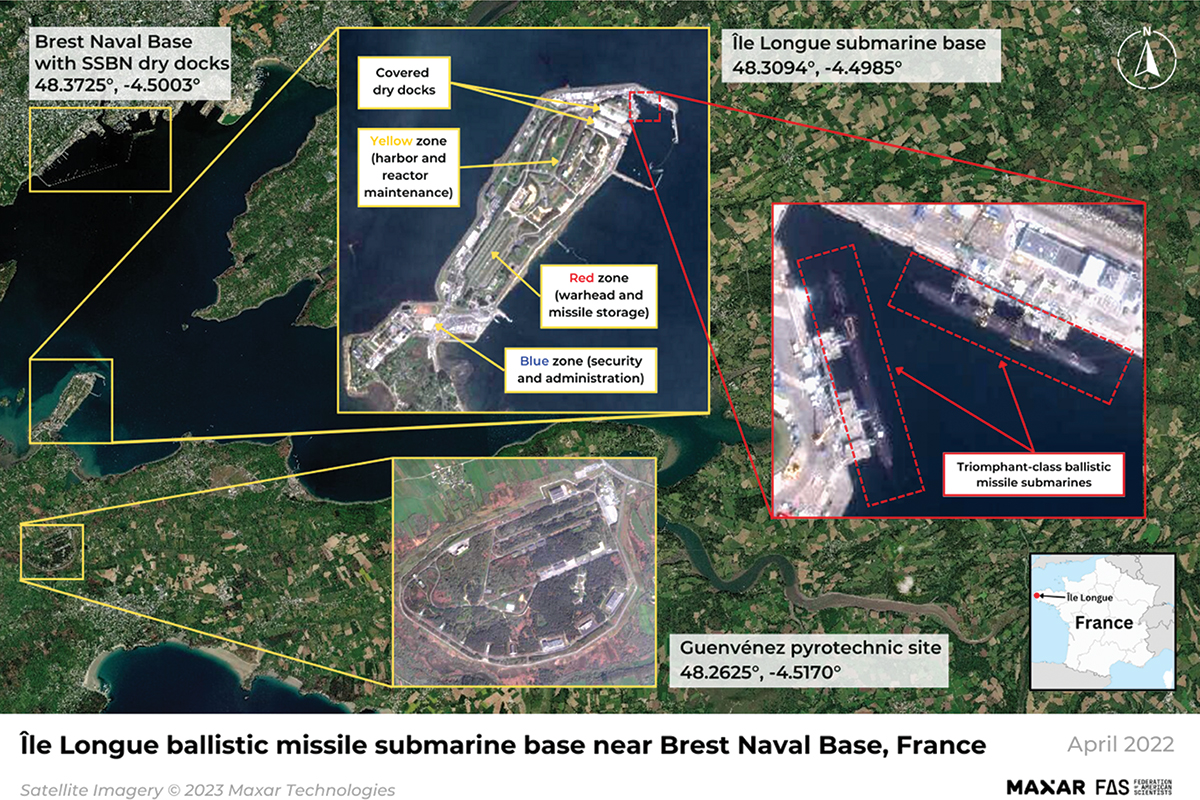
Figure 2. France’s four SSBNs are based at the Ile Longue submarine base near Brest. (Credit: 2023 Maxar Technologies / Federation of American Scientists).
图2。法国的四艘弹道导弹核潜艇(SSBN)的基地设在布雷斯特附近的长岛潜艇基地。(资料来源: 2023 Maxar技术公司/美国科学家联合会)。
Over the past few years, several infrastructure upgrades have taken place at Île Longue that are visible through satellite imagery, including the construction of a new electrical plant and pumping station, as well as what appears to be a covered bunker enclosing a rail spur that connects to the SSBNs dry docks.
在过去的几年里,长岛进行了几次基础设施升级,这些升级可以通过卫星图像看到,包括建造一座新的发电厂和泵站,以及一个似乎有盖的掩体,包围着一条连接弹道导弹核潜艇(SSBN)干码头的铁路支线。
France relocated its SSBN command center from Houilles, Yvelines to the Île Longue base in 2000, while submarine communication facilities continue to operate using France’s HWU transmitter at Rosnay and possibly other locations. French SSBNs are protected during their operations by nuclear attack submarines, maritime patrol aircraft (such as Atlantique 2s), anti-submarine frigates, and minesweepers.
2000年,法国将其弹道导弹核潜艇(SSBN)指挥中心从伊夫林、伊韦林转移到长岛基地,而潜艇通信设施继续使用法国在罗斯奈和其他地点的HWU发射机运行。法国的弹道导弹核潜艇(SSBN)在其操作过程中受到核攻击潜艇、海上巡逻机(如大西洋2号飞机)、反潜护卫舰和扫雷舰的保护。
All French SSBNs now carry the M51 SLBM, which was deployed starting in 2010 to gradually replace the M45 SLBM (Tran 2018). The last M45 was withdrawn from service in September 2016 (Assemblée Nationale 2023). The M51 has reportedly been developed in close conjunction with the Ariane 5 space-launch vehicle, and the two share a number of technological commonalities, including solid-fueled heavy boosters, electronics, wiring, and guidance systems. The three-stage M51 reportedly has a range of over 6,000 kilometers and carries a liquid-propellant post-boost vehicle, allowing for the deployment of multiple independently targetable reentry vehicles (MIRVs) and penetration aids (Tertrais 2020; Willett 2018).
所有法国弹道导弹核潜艇现在都携带M51潜射弹道导弹,该导弹于2010年开始部署,以逐步取代M45潜射弹道弹道导弹(特兰 2018)。最后一枚M45于2016年9月退役(法国国民议会 2023)。据报道,M51是与阿丽亚娜5号太空运载火箭密切合作开发的,两者有许多技术共性,包括固体燃料重型助推器、电子设备、布线和制导系统。据报道,三级M51的射程超过6000公里,携带一个液体推进剂后助推飞行器,可以部署多个独立瞄准的再入载具和突防辅助装置(泰特拉斯 2020;威利特 2018)。
The M51 is undergoing continuous iteration: The first version—the M51.1—had improved range and accuracy over the M45 and could carry up to six 100- kiloton TN75 MIRV warheads. In December 2017, the French Defense Minister noted that the second version, known as M51.2, had become operational, although the newer missile was reportedly commissioned in 2016 (Assemblée Nationale 2023; Parly 2017). The M51.2, which the French Ministry of Defense says is “capable of far greater range” than the predecessor (possibly more than 9,000 kilometers), and carries a new warhead—the tête nucléaire océanique, or TNO. The TNO is reportedly stealthier than the TN75 and reportedly weighs about 230 kilograms, approximately double that of the TN75. It is unclear how many TNO warheads the M51.2 SLBM can carry, but it is suspected that some missiles have been downloaded to carry fewer warheads to increase targeting flexibility in limited scenarios (Tertrais 2020, 57). At least three of France’s four submarines had been upgraded to the M51.2 version carrying the TNO as of May 2023; French nuclear officials stated that the TN75 remained in service with the M51.1 missile as recently as January 2023 (Assemblée Nationale 2023). Based on these and other comments from French officials and the refit schedule of France’s four submarines, it is believed that one final submarine—Le Vigilant—has yet to be upgraded.
M51正在不断迭代:第一个版本的M51.1改进了M45的射程和精度,最多可以携带六枚100千吨TN75多弹头独立重返大气层载具(MIRV)。2017年12月,法国国防部长指出,被称为M51.2的第二个版本已经投入使用,尽管据报道新型导弹已于2016年投入使用(法国国民议会 2023;帕利 2017)。法国国防部表示,M51.2比前代“射程远大于前代(可能超过9000公里)”,并携带一种新的弹头,即海洋核弹头(TNO)。据报道,TNO比TN75更隐蔽,重量约230公斤,大约是TN75的两倍。目前尚不清楚M51.2 SLBM可以携带多少TNO弹头,但有人怀疑,一些导弹被拆卸来携带更少的弹头,以增加有限情况下的瞄准灵活性(泰尔特雷 2020,57)。截至2023年5月,法国的四艘潜艇中至少有三艘升级为携带TNO的M51.2版本;法国核官员表示,直到2023年1月,TN75仍与M51.1导弹一起服役(国民议会 2023)。根据法国官员的这些和其他评论,以及法国四艘潜艇的改装时间表,人们认为最后一艘潜艇——“警戒号”——尚未升级。
A third iteration of the missile—the M51.3—began development in 2014, is scheduled for commissioning onboard one of France’s SSBNs in 2025 and will incorporate a new third stage for extended range and further improvement in accuracy (Assemblée Nationale 2023; Parly 2017). The M51.3 will carry “an adapted oceanic warhead” and a future M51.4 is also planned (Salvetti 2023).
该导弹的第三次迭代,即2014年开始开发的M51.3,计划于2025年在法国的一艘弹道导弹核潜艇上调试,并将包括一个新的第三级,用于扩大射程和进一步提高精度(国民议会 2023;帕利 2017)。M51.3将携带“一种经过改装的海洋弹头”,未来的M51.4也在计划中(萨尔维特 2023)。
Each submarine can carry a set of sixteen M51 SLBMs, but since one boat is always undergoing routine maintenance, France has only produced 48 SLBMs—enough missiles to equip each of France’s three operational SSBNs.
每艘潜艇可以携带一套16枚M51潜射弹道导弹,但由于一艘总是在进行日常维护,法国只生产了48枚潜射弹道导弹,足以装备法国三艘作战弹道导弹潜艇中的每一艘。
France typically test-launches its SLBMs from two locations: on land at DGA Essais de Missiles near Biscarrosse, and at sea near the same site. The most recent test of the M51 SLBM, on April 19, 2023, was conducted from Le Terrible, which was the first SSBN to receive the M51 system in 2010. The test was likely related to upgrades from the M51.1 to the M51.2 SLBM, enabling it to carry the newer TNO warhead (Vavasseur 2023). This was the sixth test of the M51 from a submarine, and the eleventh test of the missile overall (MAF 2023).
法国通常从两个地点试射SLBM:在比斯卡洛斯(Biscarosse)测试靶场内DGA导弹试验(法语:Essais de Missiles)部和同一地点附近的海上。M51 SLBM的最近一次测试于2023年4月19日在“可怖号”进行,这是2010年第一次接收M51系统的SSBN。该测试可能与从M51.1升级到M51.2 SLBM有关,使其能够携带更新的TNO弹头(瓦维瑟尔 2023)。这是M51在潜艇上的第六次测试,也是导弹整体的第十一次测试(MAF 2023)。
Given that the Triomphant-class SSBNs are expected to reach the end of their operational lives in the 2030s, design work has begun on the new submarine class, the SNLE−3G (Assemblée Nationale 2023). Construction of the first class is expected to start in 2023 with plans for it to begin entering operational service around 2035. The SNLE−3G will incorporate a longer hull and advanced stealth features and will be equipped with the incoming M51.3 SLBM (Assemblée Nationale 2023; Mills 2020, 11; Vavasseur 2018). A fourth iteration of the M51—the M51.4—is also planned (Assemblée Nationale 2023).
鉴于凯旋级弹道导弹核潜艇预计将在2030年结束其使用寿命,新潜艇级SNLE−3G(国民议会 2023)的设计工作已经开始。第一艘预计将于2023年开始建造,计划于2035年左右开始服役。SNLE−3G将采用更长的艇体和先进的隐身能力,并将配备即将推出的M51.3 SLBM(国民议会 2023;米尔斯 2020,11;瓦维瑟尔 2018)。M51的第四次迭代M51.4-也在计划中(国民议会 2023)。
Air-launched cruise missiles
空射巡航导弹
The second leg of France’s nuclear arsenal consists of nuclear ASMPA (air-sol moyenne portée-amélioré) air-launched cruise missiles for delivery by fighter-bombers operated by the Strategic Air Forces and the Naval Nuclear Aviation Force. The bombers assigned to the nuclear mission also serve conventional missions.
法国核武库的第二部分由核ASMPA(“中程空对地导弹”,air sol moyenne portée-amélioré)空射巡航导弹组成,由战略空军和海军核航空部队操作的战斗轰炸机投放。被指派执行核任务的轰炸机也执行常规任务。
The Strategic Air Forces (Forces Aériennes Stratégiques or FAS) operate approximately 40 nuclear-capable Rafale BF3 aircraft organized into two squadrons—the EC 1/4 “Gascogne” and EC 2/4 “La Fayette” at Saint-Dizier Air Base (Air Base 113) about 190 kilometers east of Paris (Pintat and Lorgeoux 2017). EC 2/4 operated nuclear-capable Mirage 2000Ns at Istres Air Base until June 21, 2018, when the aircraft was officially retired from the French Air Force. After the Mirage 2000N’s retirement, EC 2/4 moved from Istres to Saint-Dizier. Now both squadrons operate Rafale BF3 twin-seat strike fighters, leaving the Rafale the sole aircraft responsible for France’s nuclear strike mission (French Ministry of Defense 2018b; Jennings 2018). The FAS includes approximately 50 percent of all Rafale crews (Assemblée Nationale 2023).
战略空军(战略空军或FAS)在巴黎以东约190公里的圣迪齐尔空军基地(113空军基地)操作约40架具有核能力的阵风BF3飞机,分为两个中队,即EC 1/4“加斯科涅”和EC 2/4“拉法叶”(平塔和洛格 2017)。EC 2/4在伊斯特雷斯空军基地操作具有核能力的幻影2000N,直到2018年6月21日,该飞机已正式从法国空军退役。幻影2000N退役后,EC 2/4号从伊斯特雷斯迁至圣迪齐尔。现在,这两个中队都使用阵风BF3双座打击战斗机,使阵风成为法国唯一负责核打击任务的飞机(法国国防部 2018b;詹宁斯 2018)。FAS包括大约50%的阵风机组人员(国民大会 2023)。
The Naval Nuclear Aviation Force (Force Aéronavale Nucléaire or FANu) operates at least one squadron (11F and possibly 12F) of 10 MF3 aircraft for nuclear strike missions onboard France’s sole aircraft carrier, the Charles de Gaulle (Tertrais 2020, 58). The French carrier is the only surface ship in NATO equipped to carry nuclear weapons. The FANu and its ASMPA missiles are not permanently deployed onboard the carrier but can be rapidly deployed by the president in support of nuclear operations (Kristensen 2009; Pintat and Lorgeoux 2017). While the Charles de Gaulle’s home port is Toulon on the Mediterranean coast, the aircraft are based at the Landivisiau Naval Aviation Base in northern France. The nuclear ASMPA missiles earmarked for deployment on the carrier are thought to be co-located with ASMPAs belonging to the Strategic Air Forces at either Avord Air Base or Istres Air Base— or possibly at both.
海军核航空部队(Force Aéronavale Nucléaire或FANu)在法国唯一的航空母舰戴高乐号上运行至少一个由10架MF3飞机组成的中队(11F,可能是12F)执行核打击任务(泰尔特雷 2020,58)。法国航母是北约中唯一的一艘配备核武器的水面舰艇。海军核航空部队及其ASMPA导弹并不是永久部署在航母上,但总统可以迅速部署,以支持核行动(克里斯滕森 2009;平塔和洛格 2017)。戴高乐号的母港是地中海沿岸的土伦,而这架飞机则驻扎在法国北部的兰迪维肖海军航空基地。被指定部署在航母上的核ASMPA导弹被认为与战略空军的ASMPA位于阿佛尔(Avord)空军基地或伊斯特尔(Istres)空军基地,或者可能同时位于两者。
The ASMPA, which has a range of up to 500 kilometers, first entered service in 2009 and has completely replaced the older ASMP. France produced a total of 54 ASMPAs, including those needed for flight testing. In 2016, France launched a mid-life refurbishment program designed to maintain the missile into the 2030s (Mills 2020, 10; Scott 2022). The life-extended version is known as “air-sol moyenne portée-amélioré rénové,” or ASMPA-R, and will be equipped with the same warhead as the ASMPA, the tête nucléaire aéroportée (TNA). The missile’s producer, MBDA, says the warhead has a “medium energy” yield, possibly similar to the yield of the TNO (Kristensen 2015; MBDA n.d.). The first firing of the ASMPA-R was conducted in December 2020, and after a successful qualification firing in March 2022, France approved the upgraded missile’s serial production and refurbishment (Assemblée Nationale 2023; Direction générale de l’armement 2022; Scott 2022). Operational commissioning of the renovated missile is scheduled for the end of 2023 (Assemblée Nationale 2023).
ASMPA的射程可达500公里,于2009年首次投入使用,并完全取代了旧的ASMP。法国总共生产了54枚ASMPA,包括飞行测试所需的ASMPA。2016年,法国启动了一项中期翻新计划,旨在将导弹维持到2030年(Mills 2020,10;Scott 2022)。延长寿命的版本被称为“中程空对地导弹”(air sol moyenne portée-améliorérénové)或ASMPA-R,并将配备与ASMPA相同的弹头,即TNA。该导弹的生产商MBDA表示,弹头具有“中等能量”的当量,可能与TNO的当量相似(克里斯滕森 2015;MBDA n.d.)。ASMPA-R的首次发射于2020年12月进行,在2022年3月成功进行资格发射后,法国批准了升级后的导弹的批量生产和翻新(国民议会 2023;武装指挥 2022;斯科特 2022)。翻新后的导弹计划于2023年底投入使用(国民议会 2023)。
The French Ministry of the Armed Forces is also developing a successor to the ASMPA-R: a fourth-generation air-to-surface nuclear missile (air—sol nucléaire de 4e génération, ASN4G) with enhanced stealth and maneuverability that is scheduled to reach initial operational capability in 2035 and remain in service beyond the 2050s (Assemblée Nationale 2023). The missile will incorporate new hypersonic technologies to enable its maneuverability at high speeds (Assemblée Nationale 2023). France’s Rafale aircraft are also being modernized, and the 2023 defense budget included plans for the delivery of 13 new Rafale aircraft to its armed forces with plans for an “all Rafale” air fleet by 2035 (Élysée 2023; Jennings 2021; MAF 2022, 41). When the ASN4G missiles become operational, they will be carried by Rafale F5s—two standards higher than the current F3 version (Assemblée Nationale 2023). Ten to fifteen years later, the ASN4G will be integrated onto France’s Next Generation Fighter, which is expected to replace the Rafale (Assemblée Nationale 2023).
法国武装部队也在开发ASMPA-R的继任者:第四代空对地核导弹(air sol nuclearéaire de 4e génération,ASN4G),具有增强的隐身性和机动性,计划于2035年达到初始作战能力,并在2050年后继续服役(国民议会 2023)。该导弹将采用新的高超音速技术,使其能够在高速下机动(国民议会 2023)。法国的阵风飞机也在进行现代化改造,2023年的国防预算包括向其武装部队交付13架新的阵风飞机的计划,以及到2035年组建“全阵风”机队的计划(爱丽舍宫 2023;詹宁斯 2021;MAF 2022,41)。当ASN4G导弹投入使用时,它们将由阵风F5携带,这比目前的F3版本(国民议会 2023)高出两个标准。十到十五年后,ASN4G将被整合到法国的下一代战斗机上,预计该战斗机将取代阵风(国民议会 2023)。
At the October 2022 Euronaval exhibition, the French Armament General Directorate (DGA) revealed the latest design of the new generation aircraft carrier (Porte-Avions Nouvelle Génération, or PA-NG), which is expected to begin sea trials by 2037 and replace the Charles de Gaulle by 2038 (Peruzzi 2022; Saballa 2022). After some setbacks, France and Germany have also proceeded with their joint development of a sixth-generation combat aircraft that could potentially be nuclear-capable (Airbus n.d.; Sprenger 2018; Vincent and Bezat 2022).
在2022年10月的欧洲海军展览会上,法国装备总局(DGA)公布了新一代航空母舰(Porte Avions Nouvelle Génération,简称PA-NG)的最新设计,预计将于2037年开始海上试验,并于2038年取代戴高乐号(佩鲁齐 2022;萨巴拉 2022)。在经历了一些挫折后,法国和德国也开始联合开发可能具有核能力的第六代战斗机(空中客车公司,2018;文森特和贝扎特,2022)。
Until 2009, management and storage of France’s air-launched nuclear weapons was conducted by Dépôts-Ateliers de Munitions Spéciales (DAMS) located at Saint- Dizier, Istres, and Avord Air Bases. In 2009, these three bases were adapted for ASMPA storage and renamed to “K Buildings” (Tertrais 2020). Although nuclear-capable Rafales operated by the Strategic Air Forces are all located at Saint-Dizier, all three bases serve as dispersal and storage sites. Moreover, Avord, Istres, or both are thought to serve as storage sites for the ASMPAs assigned to the Charles de Gaulle for the Naval Nuclear Aviation Force strike mission. (See Figure 3).
直到2009年,法国空射核武器的管理和储存一直由位于圣迪齐尔、伊斯特雷斯和阿沃德空军基地的军火库(DAMS)负责。2009年,这三个基地被改造为ASMPA仓库,并更名为“K 建筑”(K Buildings)(特雷特雷斯 2020)。尽管战略空军操作的具有核能力的阵风都位于圣迪齐尔,但这三个基地都是分散和储存场所。此外,阿沃德、伊斯特雷斯或两者都被认为是分配给戴高乐号执行海军核航空部队打击任务的ASMPA的储存场所。(见图3)。
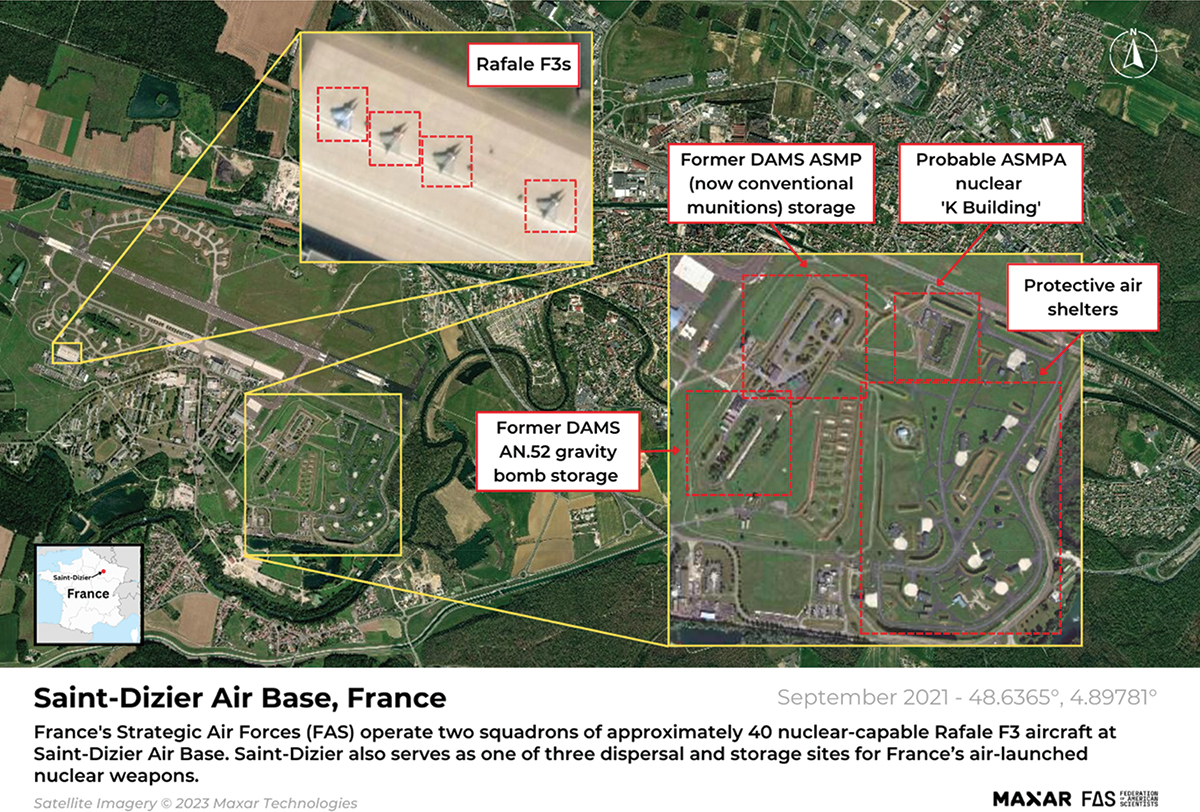
Figure 3. Saint-Dizier Air Base, France, with probable nuclear “K building.” (Credit: 2023 Maxar Technologies / Federation of American Scientists).
图3。法国圣迪齐尔空军基地,可能有核“K 建筑”。(来源:2023 Maxar Technologies/美国科学家联合会)。
Given the Rafales’ relatively short range, France’s air-launched nuclear weapons capability depends on a support fleet of refueling aircraft. France currently operates a mixed fleet of Boeing C−135FR and KC−135 R tanker aircraft. Replacing this aging fleet has been a strategic priority for nearly a decade but was delayed significantly due to budget issues. The 2019–2025 LPM provided for an accelerated replacement of the older tankers to a fleet of 15 new Airbus A330–200 “Phénix” Multi-Role Tanker Transport (MRTT) aircraft (MAF n.d.). As of March 2023, the delivery of 9 Phénix aircraft had been completed, with three more scheduled to arrive by the end of 2023 (Airbus 2023; Assemblée Nationale 2023).
鉴于“阵风”的航程相对较短,法国的空射核武器能力取决于一支由加油机组成的支援机队。法国目前运营着一支由波音C−135FR和KC−135R加油机组成的混合机队。近十年来,更换这支老化的机队一直是战略重点,但由于预算问题而被大幅推迟。2019-2025年军事规划法 (LPM)规定,将旧的加油机加速更换为15架新的空中客车A330-200“Phénix”多功能加油运输(MRTT)飞机(MAF n.d.)。截至2023年3月,9架“Phénix”飞机的交付已经完成,另有3架计划在2023年底前抵达(空中客车 2023;国民议会 2023)。
The nuclear weapons complex
核武器综合体
France’s nuclear weapons complex is managed by the Direction des Applications Militaires (DAM), a department within the Nuclear Energy Commission (Commissariat à l’énergie atomique et aux énergies renouvelables, or CEA). DAM is responsible for research, design, manufacture, operational maintenance, and dismantlement of nuclear warheads.
法国的核武器综合体由核能委员会下属的军事应用指挥部(DAM)管理,这是核能委员会的一个部门(能源供应局,或CEA)。DAM负责核弹头的研究、设计、制造、运行维护和拆卸。
Warhead design and simulation takes place at the DAM center in Bruyères-le-Châtel, about 30 kilometers south of Paris. The center houses the Tera 1000—Europe’s most powerful supercomputer with a 25 petaflop capacity—and employs about half the people affiliated with the military section of the Nuclear Energy Commission (CEA 2016).
弹头设计和模拟在巴黎以南约30公里的布吕耶尔勒沙泰尔的DAM中心进行。该中心拥有Tera 1000欧洲最强大的超级计算机,其运算能力为25 PB,雇佣了核能委员会(CEA 2016)军事部门约一半的员工。
The Commission’s Valduc Center, about 30 kilometers northwest of Dijon, is responsible for nuclear warhead production, maintenance, storage, and dismantlement. The site has recently expanded as a result of the 2010 French-British Teutates Treaty, an agreement to collaborate on technology associated with the two countries’ respective nuclear weapons stockpiles. The Epure facility at Valduc includes three high-power radiographic axes, including the AIRIX X-ray generator, which will “make it possible to characterize, to the highest level of precision, the state and hydrodynamic behavior of materials, under the conditions encountered in the pre-nuclear phase of weapon functioning,” as the Nuclear Energy Commission said in its 2017 annual report (CEA 2017, 4; Teutates n.d.). This function is critical to maintaining and developing France’s nuclear weapons in the absence of live nuclear test explosions. (See Figure 4).
委员会的瓦尔杜克中心位于第戎西北约30公里处,负责核弹头的生产、维护、储存和拆卸。该基地最近因2010年《法英条约》而扩大,该条约旨在就两国各自核武器库存的相关技术进行合作。瓦尔杜克的Epure设施包括三个高功率射线照相轴,包括AIRIX X射线发生器,正如核能委员会在其2017年年度报告(CEA 2017,4;特乌塔蒂斯 n.d.)中所说,这将“使我们能够在核武器运行前阶段遇到的条件下,以最高精度表征材料的状态和流体动力学行为”。这一职能对于在没有实弹核试爆的情况下维持和发展法国的核武器至关重要。(见图4)。
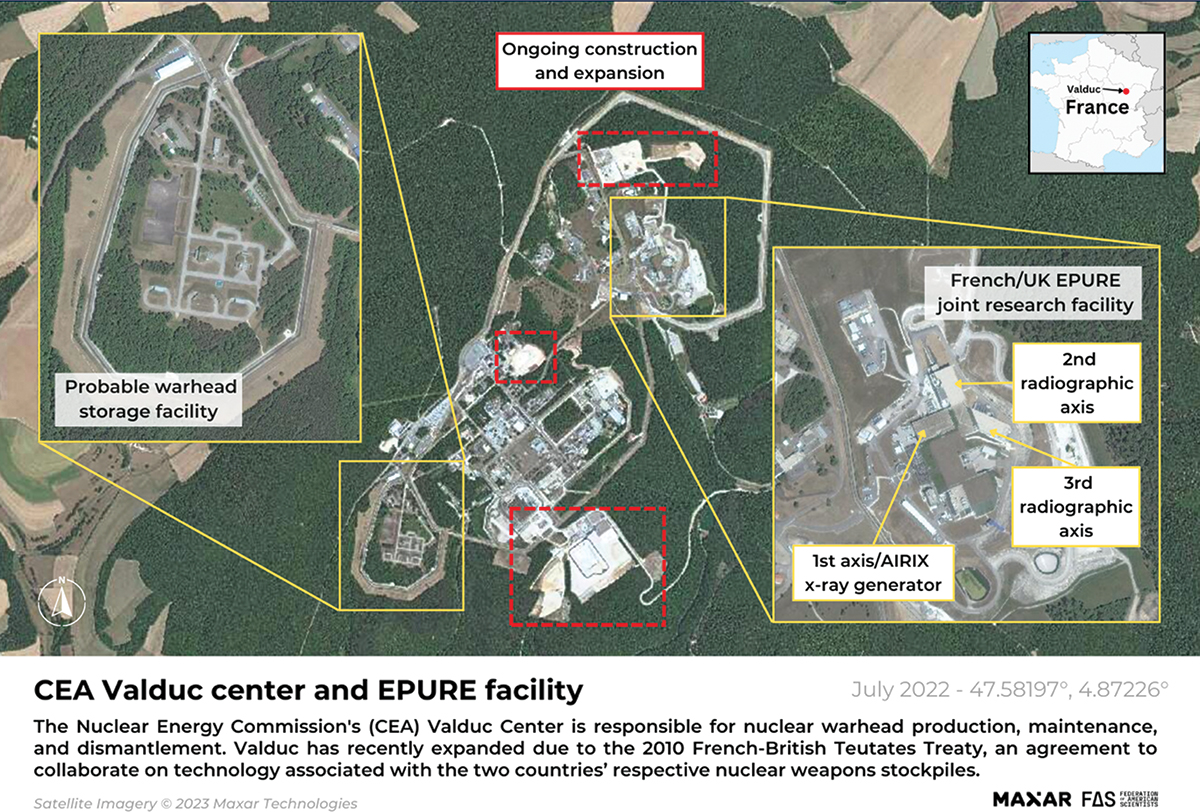
Figure 4. The CEA Valduc complex is responsible for the production, maintenance, storage, and dismantlement of France’s nuclear warheads. (Credit: 2023 Maxar Technologies / Federation of American Scientists).
图4。CEA 瓦尔杜克综合设施负责法国核弹头的生产、维护、储存和拆卸。(资料来源: 2023 Maxar技术公司/美国科学家联合会)。
Finally, the Nuclear Energy Commission’s CESTA (Centre d’Études Scientifiques et Techniques d’Aquitaine) near Le Barp is responsible for designing equipment for nuclear weapons and reentry vehicles, as well as for coordinating the development of nuclear warheads. The Megajoule laser, France’s equivalent to the US National Ignition Facility, is located at the same site. Construction on the Megajoule began in 2005 and it was first used to conduct experiments in 2014 (CEA 2016). It is designed to validate theoretical models of nuclear weapons detonations, and therefore plays an important role in France’s nuclear simulation program.
最后,勒巴普附近的核能委员会科学与技术中心(阿基坦科学和技术中心)负责核武器和再入载具的设计装备,并协调核弹头的开发。兆焦耳激光器,相当于法国的美国国家点火设施,位于同一地点。兆焦耳的建造始于2005年,并于2014年首次用于进行实验(CEA 2016)。它旨在验证核武器引爆的理论模型,因此在法国的核模拟计划中发挥着重要作用。
Research for this publication was carried out with generous contributions from the John D. and Catherine T. MacArthur Foundation, the New-Land Foundation, Ploughshares Fund, the Prospect Hill Foundation, Longview Philanthropy, the Stewart R. Mott Foundation, the Future of Life Institute, Open Philanthropy, and individual donors.
本出版物的研究得到了约翰·D·和凯瑟琳·T·麦克阿瑟基金会、新土地基金会、犁头基金会、展望山基金会、Longview慈善机构、斯图尔特·R·莫特基金会、生命未来研究所、开放慈善机构和个人捐助者的慷慨捐款。
补充资料(来源:互联网节选):
法国战略核潜艇力量(Force Océanique Stratégique,FOST)驻扎在布雷斯特的海军基地
布雷斯特(法语:Brest)布雷斯特位于布列塔尼半岛西端、布雷斯特湾的北岸,是布列塔尼大区菲尼斯泰尔省的城市,是一座海港城市,也是法国西部最大的海军基地。布雷斯特也是一座造船厂,法国对美洲进行黄金输送的时候就在这座城市修建船只和卸货。这座城市的造船厂修建过许多驱逐舰、运输舰,其中包括最为著名的法国戴高乐号核动力航空母舰。
布雷斯特(法语:Brest)布雷斯特位于布列塔尼半岛西端、布雷斯特湾的北岸,是布列塔尼大区菲尼斯泰尔省的城市,是一座海港城市,也是法国西部最大的海军基地。布雷斯特也是一座造船厂,法国对美洲进行黄金输送的时候就在这座城市修建船只和卸货。这座城市的造船厂修建过许多驱逐舰、运输舰,其中包括最为著名的法国戴高乐号核动力航空母舰。
从罗马时期开始,布雷斯特(Brest)就是著名的军事要塞,其战略地位的重要性自然不言而喻。然而,这种优越的地理位置在第二次世界大战中却给它带来了负面作用。当时布雷斯特(Brest)曾经遭受到盟军轰炸机的猛烈轰炸,因为绝不能让德国人攻占该城,在战争中确立优势。
1944年夏,此市于布雷斯特之战几乎尽毁于兵燹(xiǎn)仅三栋建筑未坍。
战后,西德政府向无家可归的布雷斯特市民支付了数十亿美元的赔款。
布雷斯特扼守着英吉利海峡西南出口。这里港阔水深,曾是法国最大的军港和重要的贸易港。二战时期,德国占领布雷斯特后,曾将之作为U型潜艇基地。1972年,法国在布雷斯特的长岛建立了核潜艇基地。目前,这里是法国海军现役4艘“凯旋”级战略核潜艇的母港。
基地按照功能的不同分成三大区域,分别为生活保障区、军火库区、港口与干船坞区。这里的两座多功能干船坞同时具备消磁站、爆炸物处理码头、核潜艇改装码头和核潜艇改装干船坞的功能。
在法国海军中,战略海洋部队主要由两支核潜艇部队组成,一支是战略核潜艇舰队,一支是攻击型核潜艇舰队。战略海洋部队的司令部机关就设在长岛核潜艇基地内。此外,这里还驻有战略核潜艇舰队、长岛核潜艇基地部队以及核潜艇部队艇员训练中心等单位。
驻该基地的战略核潜艇舰队的主要任务是保证所有现役战略核潜艇的作战、实战演习以及训练的临战条件。目前部署在这里的“凯旋”级战略核潜艇同时装备有M45型和M51型潜射弹道导弹。其中M51型潜射弹道导弹的射程最远可达到13000千米,是法国海军战略核力量的重要体现。不难看出,长岛核潜艇基地的安全直接关系到法国的战略安全。
鉴于此,目前长岛核潜艇基地是法国最重要的军事保密区之一,法国要求谷歌公司在地图上将该基地位置打上马赛克。这也是外人很难窥其真容的原因。
上一篇:Countering tomorrow’s UUV threats – from concept to reality 下一篇:The US submarine force should be silent no more
| The Booker dilemma: inside US Army transformation
“布克”困境:美国陆军转型内幕 |
| The decision to cancel the M10 Booker light tank is at the core of a reordering of US Army planning.... [2025-07-16] |
| Focus: A fragile balance in Asia, China has become leading military power in the
焦点:亚洲平衡脆弱,中国已成为该地区的主要军事力量 |
| However, China's rapid military growth in this area is tipping the balance in favor of regional power. ... [2024-08-27] |
| Small drones will soon lose combat advantage, French Army chief says
法国陆军总司令表示,小型无人机将很快失去战斗优势 |
| By Rudy Ruitenberg Thursday, Jun 20, 2024 作者:鲁迪瑞滕伯格 2024年6月20日星期四 French Army Chief of Staff Gen. Pierre Schill inspecting a Rapid Eagle anti-drone system at the Eurosatory defense show in Paris on June 19, 202... [2024-08-18] |
| What’s next for Ukraine’s incursion into Russia?
乌克兰入侵俄罗斯的下一步是什么? |
| Ukraine’s forces have surprised us all with its recent incursion into Russia’s Kursk Oblast since the operation to turn the tide of the war,... [2024-08-17] |

